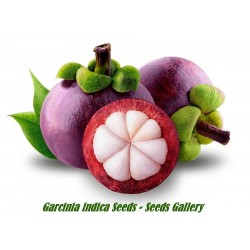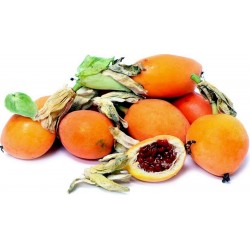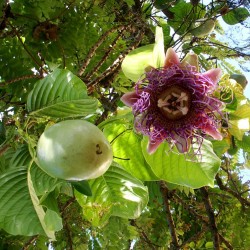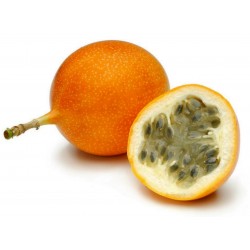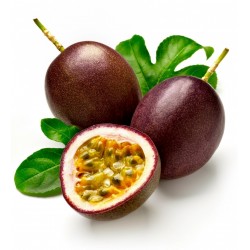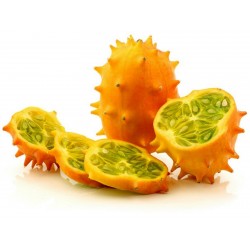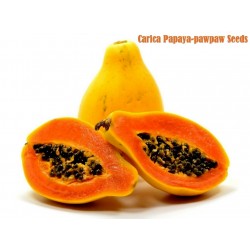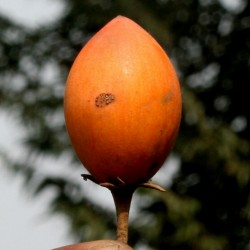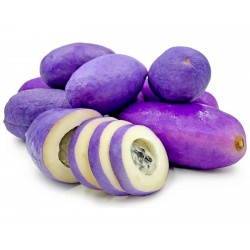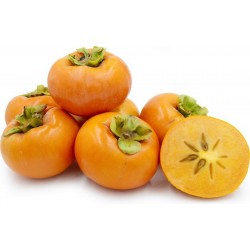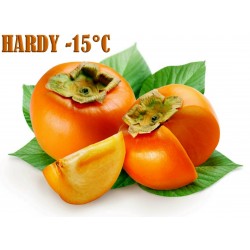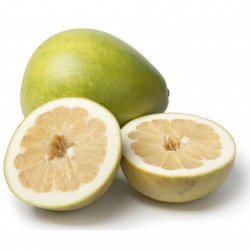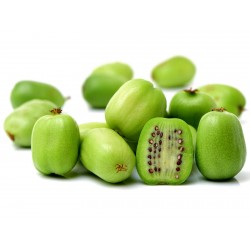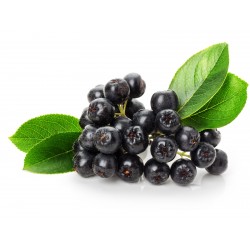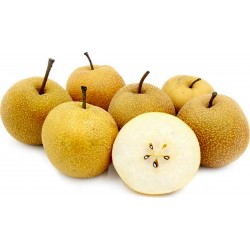Seeds Gallery EU,
5/
5
<h2><strong>Graines Pamplemousse et pomélo Rusticité: résistent au gel</strong></h2>
<h2><span style="color:#ff0000;"><strong>2 graines par sachet.<br /></strong></span></h2>
<div>Pamplemousse et pomélo, sont des noms vernaculaires ambigus qui désignent en français deux types de fruits dont les noms peuvent être confondus et qui proviennent de deux espèces différentes du genre Citrus, de la famille des Rutaceae. Ces fruits sont nommés commercialement « agrumes » à l'instar des citrons, oranges et mandarines:</div>
<div>Citrus maxima (aussi Citrus grandis ou Citrus decumana) est un arbre fruitier nommé pamplemoussier. Il est issu d'Asie du Sud-Est(Indonésie, Malaisie). Son fruit à l'écorce épaisse de couleur jaune, rosée ou verdâtre est une baie comestible, composée de 16 à 18 quartiers remplis de pépins.</div>
<div>Citrus ×paradisi est un hybride entre le pamplemoussier et l'oranger doux (Citrus maxima × Citrus sinensis). Son fruit, à l'écorce mince de couleur jaune ou rose est une baie comestible légèrement sucrée composée d'une douzaine de quartiers. Il pousse en grappes, d'où son nom anglais de « grapefruit ».</div>
<div>Étymologie et origine de la confusion</div>
<div>Le mot « pamplemousse » est emprunté au tamoul « pampa limāsu » (பம்பரமாசு)1. Le mot est attesté en français dès la fin duxviie siècle pour désigner C. maxima, puis au xxe siècle pour désigner également C. paradisi 2.</div>
<div>Le mot pomélo est emprunté à l'anglais pomelo ; son origine est incertaine : certains ont suggéré une composition pome-melon, hypothèse jugée douteuse, car une telle forme composée n'a jamais été attestée ; d'autres, une altération du mot néerlandais pompelmoes. Le mot pomelo est attesté en anglais au début du xixe siècle sous la forme pommelo, et désignait d'abord C. maxima, mais aussi C. paradisi durant la seconde moitié du xixe siècle3. En français, le terme a fait son apparition au début du xxe siècle4.</div>
<div>Le mot « pomelo » est toutefois resté pendant longtemps peu connu du public, et les C. paradisi étaient commercialisés sous le nom de pamplemousse, comme l'atteste cette citation datant de 1968 : « L'Encyclopédie horticole (...) ajoute que sur les marchés européens, notamment en France, les « grape-fruits » se vendent sous le nom de pamplemousse. Leur nom scientifique « pomelo », n'est évidemment connu que des spécialistes. » (Ac. Can-Fr. 1968)2. Selon P. Robert, auteur de Les Agrumes dans le monde (1947), « on eût probablement évité cette confusion [entre pamplemousse et pomelo] en adoptant pour le fruit du pomélo le nom américain de grape-fruit sous lequel il est commercialement connu et qui évoque la fructification en grappes de cette espèce »2.</div>
<div>Aujourd'hui, les sources averties font soigneusement la distinction, en utilisant « pamplemousse » pour C. maxima et « pomélo » pour C. paradisi, et cela tant en France5,6,7 qu'au Québec8,9. Cependant, dans l'usage populaire, « pamplemousse » est resté très courant pour C. paradisi, et « pomélo » est même parfois utilisé pour C. maxima, comme l'atteste cette citation : « Le pomelo est bien souvent confondu, à tort, avec le pamplemousse. Pour accentuer la confusion, ce dernier, énorme, très lourd (dont la chair remplie de nombreux pépins est recouverte par une peau épaisse et aromatique) est parfois commercialisé en France sous la dénomination de pomelo exotique »10. La confusion est accentuée par l'usage actuel de pomelo en anglais pour désigner C. maxima.</div>
<div>Il faut aussi mentionner les nouveaux hybrides et cultivars qui ne font qu'ajouter à la confusion comme le pamplemousse chinois : un fruit hybride entre l’orange de chine et le pamplemousse, commercialisé en France sous le nom de « Pomelo chinois » (en anglais shatian pomelo)11.</div>
<center>
<table class="wikitable"><caption><span><strong>Appellations en français et dans quelques langues européennes</strong></span></caption>
<tbody><tr><th><span> </span></th>
<th><span><em>Citrus maxima</em> (l'Asiatique vert)</span></th>
<th><span><em>Citrus</em> ×<em>paradisi</em> (l'Occidental hybride)</span></th>
</tr><tr><th colspan="3"><span>usage en botanique et horticulture en français<sup class="reference">5</sup><sup class="reference cite_virgule">,</sup><sup class="reference">12</sup><sup class="reference cite_virgule">,</sup><sup class="reference">13</sup></span></th>
</tr><tr><th><span> </span></th>
<td><span>pamplemousse</span></td>
<td><span>pomélo</span></td>
</tr><tr><th colspan="3"><span>usage commercial et familier en français</span></th>
</tr><tr><th><span>Belgique</span></th>
<td><span><sup class="need_ref_tag">[réf. nécessaire]</sup></span></td>
<td><span>pamplemousse<sup class="reference">14</sup> <small>(abus de langage)</small></span></td>
</tr><tr><th><span>Canada</span></th>
<td><span>pamplemousse<sup class="reference">9</sup><sup class="reference cite_virgule">,</sup><sup class="reference">15</sup></span></td>
<td><span>pomélo <small>(ou pomelo)</small> , grapefruit <small>(anglicisme)</small> ou pamplemousse <small>(abus de langage)</small><sup class="reference">9</sup><sup class="reference cite_virgule">,</sup><sup class="reference">16</sup></span></td>
</tr><tr><th><span>États-Unis</span></th>
<td><span><sup class="need_ref_tag">[réf. nécessaire]</sup></span></td>
<td><span>chadègue<sup class="reference">17</sup><small>(en cajun)</small></span></td>
</tr><tr><th><span>France<sup class="reference">6</sup><sup class="reference cite_virgule">,</sup><sup class="reference">7</sup></span></th>
<td><span>pamplemousse<sup class="reference">18</sup></span></td>
<td><span>pomélo ou pamplemousse <small>(abus de langage)</small><sup class="reference">19</sup><sup class="reference cite_virgule">,</sup><sup class="reference">20</sup></span></td>
</tr><tr><th><span>Suisse</span></th>
<td><span>pomélo</span></td>
<td><span>grapefruit<sup class="reference">21</sup> ou pamplemousse<sup class="reference">22</sup></span></td>
</tr><tr><th colspan="3"><span>usage dans d'autres langues</span></th>
</tr><tr><th><span>anglais<sup class="reference">23</sup></span></th>
<td><span>pomelo (pummelo, Chinese grapefruit, shaddock, etc.)</span></td>
<td><span>grapefruit</span></td>
</tr><tr><th><span>espagnol</span></th>
<td><span>pampelmusa, cimboa</span></td>
<td><span>pomelo, (toronja)</span></td>
</tr><tr><th><span>italien</span></th>
<td><span>pomelo, pummelo, pampaleone</span></td>
<td><span>pompelmo</span></td>
</tr><tr><th><span>portugais</span></th>
<td><span>pomelo</span></td>
<td><span>toronja</span></td>
</tr><tr><th><span>allemand</span></th>
<td><span>Pampelmuse, (Riesenorange, Adamsapfel, Pumelo)</span></td>
<td><span>Grapefruit</span></td>
</tr><tr><th><span>néerlandais</span></th>
<td><span>pompelmoes</span></td>
<td><span>grapefruit</span></td>
</tr><tr><th><span>polonais</span></th>
<td><span>pomarańcza olbrzymia, pomelo</span></td>
<td><span>grejpfrut</span></td>
</tr></tbody></table></center><center></center>
<div>
<table border="1" cellspacing="0" cellpadding="0"><tbody><tr><td colspan="2" valign="top" width="100%">
<p><span><strong>Sowing Instructions</strong></span></p>
</td>
</tr><tr><td valign="top" nowrap="nowrap">
<p><span><strong>Propagation:</strong></span></p>
</td>
<td valign="top">
<p><span>Seeds</span></p>
</td>
</tr><tr><td valign="top" nowrap="nowrap">
<p><span><strong>Pretreat:</strong></span></p>
</td>
<td valign="top">
<p><span>0</span></p>
</td>
</tr><tr><td valign="top" nowrap="nowrap">
<p><span><strong>Stratification:</strong></span></p>
</td>
<td valign="top">
<p><span>0</span></p>
</td>
</tr><tr><td valign="top" nowrap="nowrap">
<p><span><strong>Sowing Time:</strong></span></p>
</td>
<td valign="top">
<p><span>all year round</span></p>
</td>
</tr><tr><td valign="top" nowrap="nowrap">
<p><span><strong>Sowing Depth:</strong></span></p>
</td>
<td valign="top">
<p><span>1 cm</span></p>
</td>
</tr><tr><td valign="top" nowrap="nowrap">
<p><span><strong>Sowing Mix:</strong></span></p>
</td>
<td valign="top">
<p><span>Coir or sowing mix + sand or perlite</span></p>
</td>
</tr><tr><td valign="top" nowrap="nowrap">
<p><span><strong>Germination temperature:</strong></span></p>
</td>
<td valign="top">
<p><span>25 ° C +</span></p>
</td>
</tr><tr><td valign="top" nowrap="nowrap">
<p><span><strong>Location:</strong></span></p>
</td>
<td valign="top">
<p><span>bright + keep constantly moist not wet</span></p>
</td>
</tr><tr><td valign="top" nowrap="nowrap">
<p><span><strong>Germination Time:</strong></span></p>
</td>
<td valign="top">
<p><span>2-8 weeks</span></p>
</td>
</tr><tr><td valign="top" nowrap="nowrap">
<p><span><strong>Watering:</strong></span></p>
</td>
<td valign="top">
<p><span>Water regularly during the growing season</span></p>
</td>
</tr><tr><td valign="top" nowrap="nowrap">
<p><span><strong> </strong></span></p>
</td>
<td valign="top">
<p><br /><span><em>Copyright © 2012 Seeds Gallery - Saatgut Galerie - Galerija semena. </em><em>All Rights Reserved.</em></span></p>
</td>
</tr></tbody></table></div>
V 27

